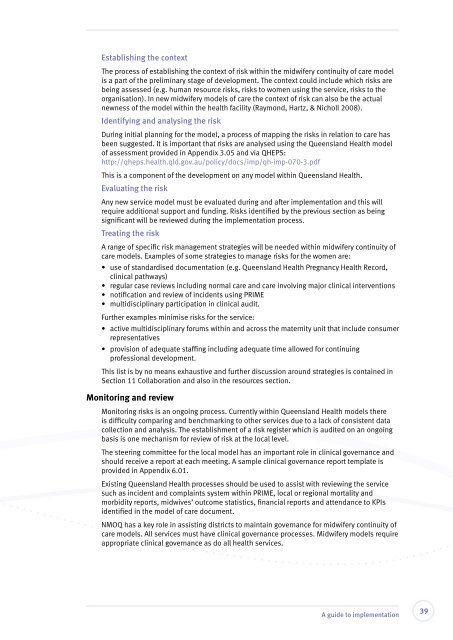Delivering continuity of midwifery care to Queensland women
Delivering continuity of midwifery care to Queensland women
Delivering continuity of midwifery care to Queensland women
Create successful ePaper yourself
Turn your PDF publications into a flip-book with our unique Google optimized e-Paper software.
Establishing the context<br />
The process <strong>of</strong> establishing the context <strong>of</strong> risk within the <strong>midwifery</strong> <strong>continuity</strong> <strong>of</strong> <strong>care</strong> model<br />
is a part <strong>of</strong> the preliminary stage <strong>of</strong> development. The context could include which risks are<br />
being assessed (e.g. human resource risks, risks <strong>to</strong> <strong>women</strong> using the service, risks <strong>to</strong> the<br />
organisation). In new <strong>midwifery</strong> models <strong>of</strong> <strong>care</strong> the context <strong>of</strong> risk can also be the actual<br />
newness <strong>of</strong> the model within the health facility (Raymond, Hartz, & Nicholl 2008).<br />
Identifying and analysing the risk<br />
During initial planning for the model, a process <strong>of</strong> mapping the risks in relation <strong>to</strong> <strong>care</strong> has<br />
been suggested. It is important that risks are analysed using the <strong>Queensland</strong> Health model<br />
<strong>of</strong> assessment provided in Appendix 3.05 and via QHEPS:<br />
http://qheps.health.qld.gov.au/policy/docs/imp/qh-imp-070-3.pdf<br />
This is a component <strong>of</strong> the development on any model within <strong>Queensland</strong> Health.<br />
Evaluating the risk<br />
Any new service model must be evaluated during and after implementation and this will<br />
require additional support and funding. Risks identified by the previous section as being<br />
significant will be reviewed during the implementation process.<br />
Treating the risk<br />
A range <strong>of</strong> specific risk management strategies will be needed within <strong>midwifery</strong> <strong>continuity</strong> <strong>of</strong><br />
<strong>care</strong> models. Examples <strong>of</strong> some strategies <strong>to</strong> manage risks for the <strong>women</strong> are:<br />
• use <strong>of</strong> standardised documentation (e.g. <strong>Queensland</strong> Health Pregnancy Health Record,<br />
clinical pathways)<br />
• regular case reviews including normal <strong>care</strong> and <strong>care</strong> involving major clinical interventions<br />
• notification and review <strong>of</strong> incidents using PRIME<br />
• multidisciplinary participation in clinical audit.<br />
Further examples minimise risks for the service:<br />
• active multidisciplinary forums within and across the maternity unit that include consumer<br />
representatives<br />
• provision <strong>of</strong> adequate staffing including adequate time allowed for continuing<br />
pr<strong>of</strong>essional development.<br />
This list is by no means exhaustive and further discussion around strategies is contained in<br />
Section 11 Collaboration and also in the resources section.<br />
Moni<strong>to</strong>ring and review<br />
Moni<strong>to</strong>ring risks is an ongoing process. Currently within <strong>Queensland</strong> Health models there<br />
is difficulty comparing and benchmarking <strong>to</strong> other services due <strong>to</strong> a lack <strong>of</strong> consistent data<br />
collection and analysis. The establishment <strong>of</strong> a risk register which is audited on an ongoing<br />
basis is one mechanism for review <strong>of</strong> risk at the local level.<br />
The steering committee for the local model has an important role in clinical governance and<br />
should receive a report at each meeting. A sample clinical governance report template is<br />
provided in Appendix 6.01.<br />
Existing <strong>Queensland</strong> Health processes should be used <strong>to</strong> assist with reviewing the service<br />
such as incident and complaints system within PRIME, local or regional mortality and<br />
morbidity reports, midwives’ outcome statistics, financial reports and attendance <strong>to</strong> KPIs<br />
identified in the model <strong>of</strong> <strong>care</strong> document.<br />
NMOQ has a key role in assisting districts <strong>to</strong> maintain governance for <strong>midwifery</strong> <strong>continuity</strong> <strong>of</strong><br />
<strong>care</strong> models. All services must have clinical governance processes. Midwifery models require<br />
appropriate clinical governance as do all health services.<br />
A guide <strong>to</strong> implementation<br />
39
















